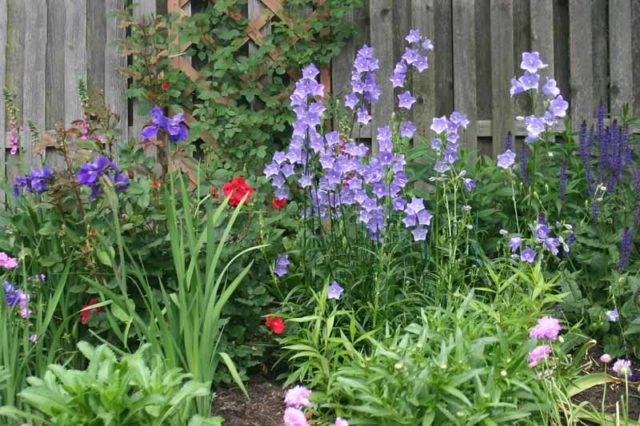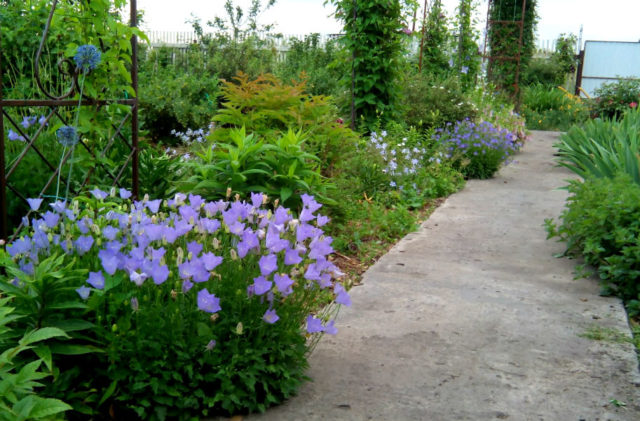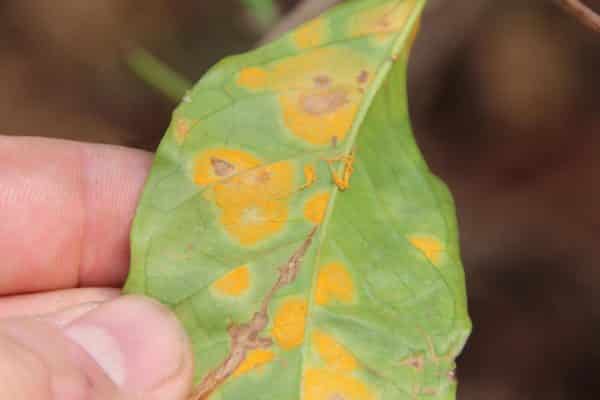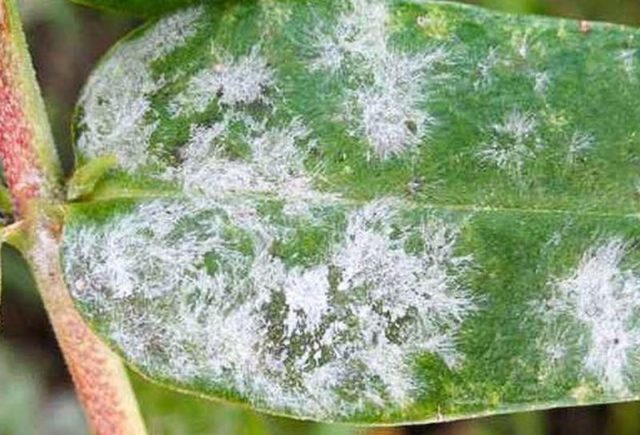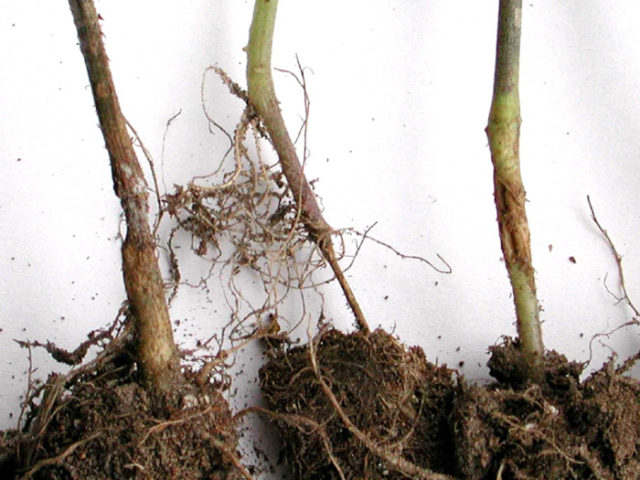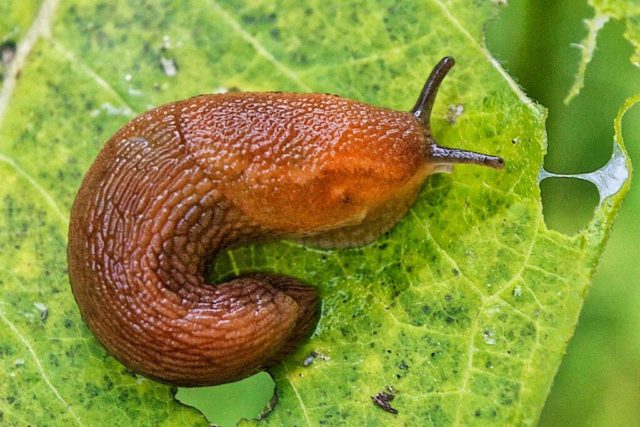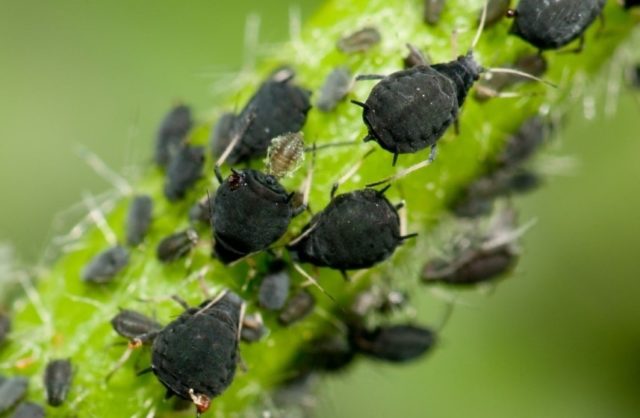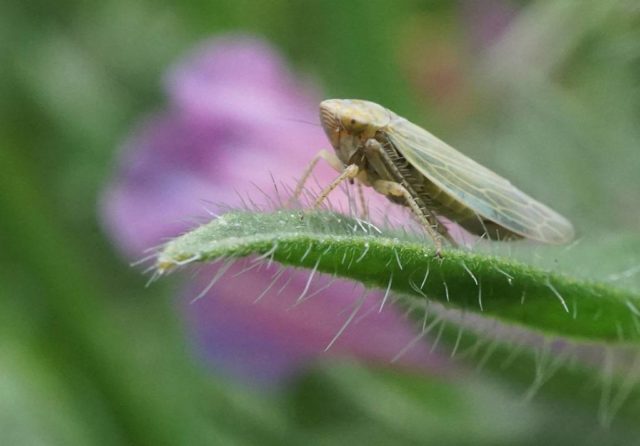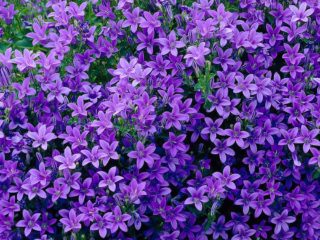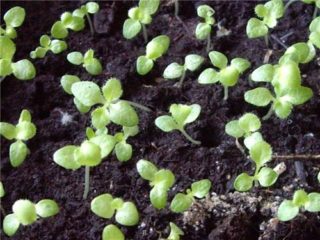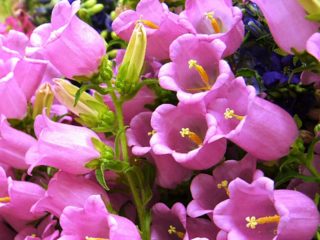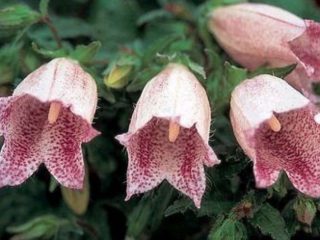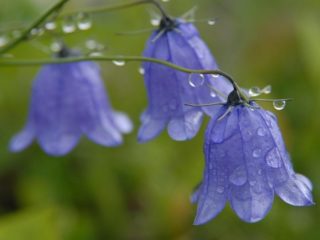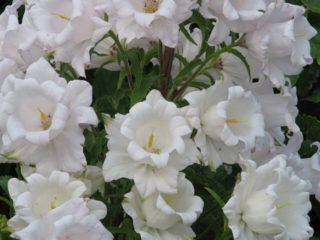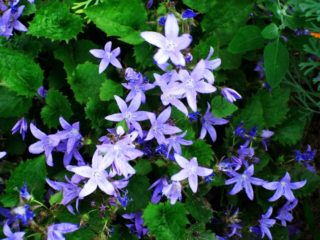Content
Peach bellflower is a perennial flowering plant that is often found in the wild and is cultivated in summer cottages. It is interesting to study popular varieties, as well as the main rules of care.
Description of peach bell
Peach-leaved bell (Latin Campanula persicifolia) is a herbaceous perennial with straight bare stems, mostly simple, sometimes branched, with a weakly pronounced ribbing. The leaves of the plant are narrow, lanceolate or linear, dark green in shade and shiny, crenate at the edges. They are very similar to peach, which explains the name. The stems and leaves contain milky sap.
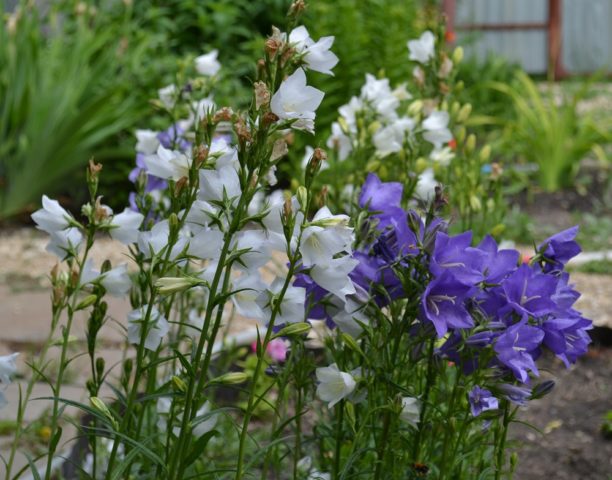
Peach-leaved bell is a rare plant in the wild from the Red Book
The perennial grows in height from 40 to 160 cm, most often it rises by about 120 cm in adulthood. It spreads slightly, the width of the bush usually does not exceed 50 cm.
The peach bell is considered a light-loving plant. Under the cover of trees and shrubs, it can also develop, but it does not tolerate a dense shade, especially in combination with swampy soil. According to the degree of frost resistance, it belongs to climatic zone 4 and winters well at temperatures from -29 to -35 ° C.
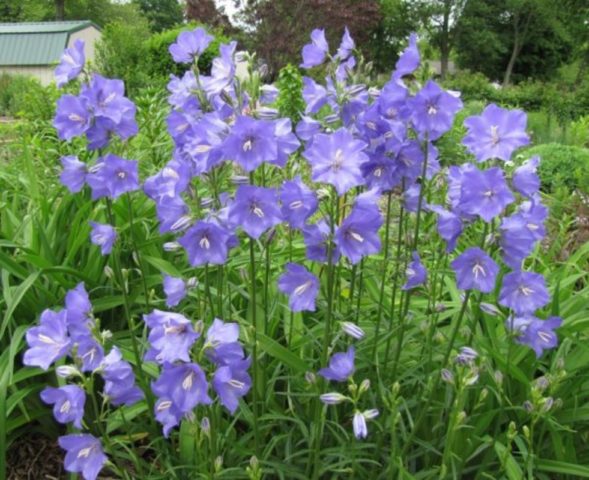
The peach-leaved bell quickly reaches its maximum size, but remains compact
With good care, a perennial grows quickly. But he is not inclined to aggressive spread over the site.
What is the root system of a peach bell
The type of root system of the peach bell is fusiform and branched, strongly twisted. Numerous feeding processes extend from the main thick rod. For this reason, even a short perennial is difficult to pull out entirely from the soil; it must be carefully dug out or cut off.
What are the inflorescences of a peach bell
From June to early September, the perennial is decorated with flowers, and the decorative period lasts for about a month. The exact timing depends on the particular variety.
The flowers of the peach-leaved bell are attached to short pedicels and are small drooping funnels up to 4 cm in diameter, consisting of 5 petals. Inside are glands that secrete sweet nectar. The buds are collected in small one-sided brushes of 3-7 pieces, their shade is most often blue, purple or blue, rarely white. At the end of flowering in August or September, the perennial bears fruit - small boxes with seeds.
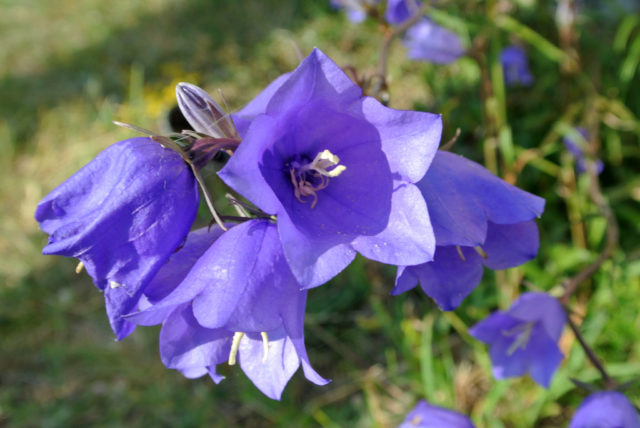
Peach bell flowers are funnel-shaped
The abundance of flowering peach bellflower depends on the growing conditions. The perennial grows well in sunny and moderately humid areas, but does not like thick shade and swampiness, and in such places it always looks faded.
Where does the peach-leaved bell grow
The perennial peach-leaved bell is widespread in Eurasia. You can meet him in Europe and the Caucasus, in Asia Minor and in the Himalayas. In Russia, it grows in the middle zone, in the southern regions and in the Western Ciscaucasia, it comes across in the foothills of the Urals, but only up to Yekaterinburg.
The perennial plant mainly chooses light deciduous and mixed forests, forest edges and shrubs. It can be found along river banks and in ravines.
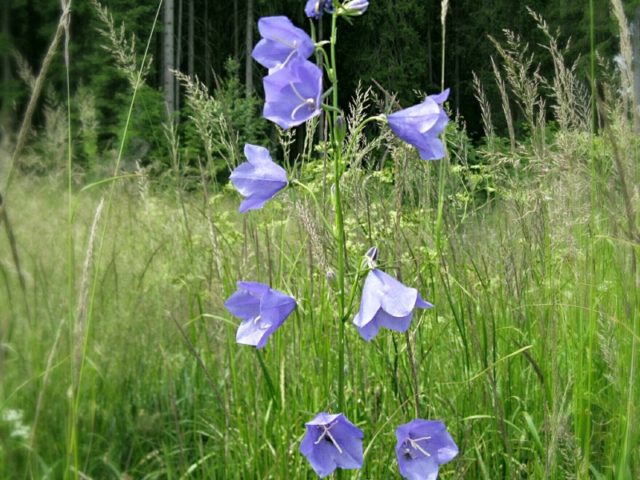
Peach-leaved bell grows mainly on light edges
It is recommended to grow perennials in areas of its natural habitat. The culture takes root well in the European part of Russia and in the south, in the Urals and in Western Siberia. But the climate of Eastern Siberia and the northern belts may turn out to be too harsh.
Why is the peach-leaved bell in the Red Book
In the Red Book of Russia, the peach-leaved bell is noted as a species that is declining in numbers. In addition to the fact that the perennial looks very decorative during flowering, its green parts and rhizomes have medicinal properties. The population actively collects the plant, and this negatively affects the population.
Peach bell varieties
The beautiful herbaceous perennial is represented by several decorative varieties. For a summer cottage, you can pick up the most interesting plant.
Alba Plena
One of the most beautiful varieties of the peach-leaved bell, Alba Plena, rises 50 cm above the ground. In June, it brings large double white buds and retains its decorative effect for a month. Not only the flowers of the plant look attractive, but also the shiny dark green leaves.
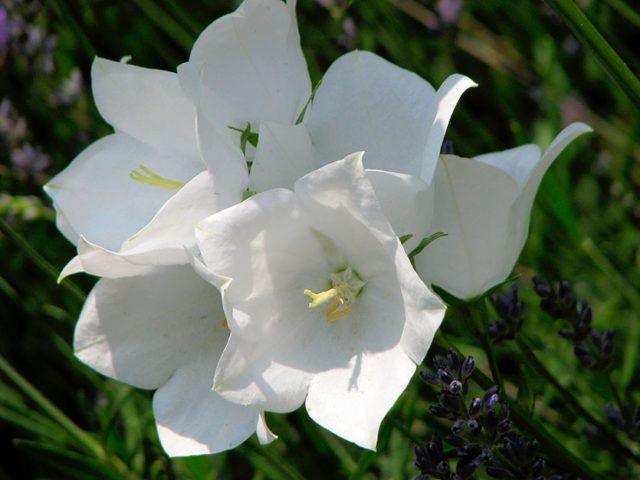
Alba Plena grows in width to an average of 20 cm, so it is recommended to plant the variety tightly
Snow White
A high variety of Russian breeding Snow White stretches up to 80 cm above the ground and grows almost as widely. In mid-June, it releases large quantities of buds. The white peach-leaved bell retains its attractiveness until the end of August, but even after all the flowers have wilted, it continues to delight with beautiful foliage.
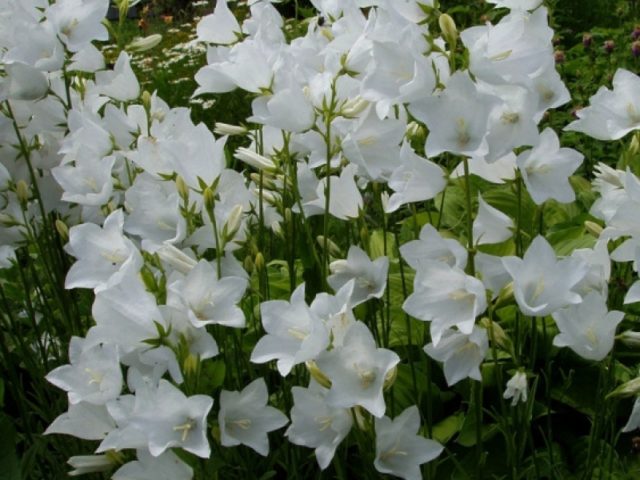
The peak flowering of the Snow White variety falls on the first 2 weeks after the appearance of the buds.
La belle blue
La Belle Blue is a variety with large lilac double-type buds. The stem of the peach-leaved bell rises up to 60 cm. During the flowering period, the plant enters in July and retains its maximum attractiveness until the end of August.
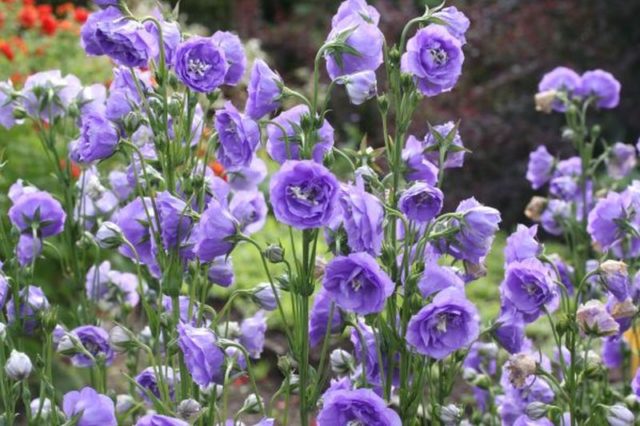
La Belle Blue prefers well-lit areas for growth
Takion blue
Takion Blue is a beautiful compact variety up to 50 cm in height. It brings the first flowers in late spring, the buds are blue in color with a purple tint, the petals are lighter in the center than at the edges. If in the middle of summer you cut off wilted flower stalks, then with a high probability Takion Blue will bloom again.
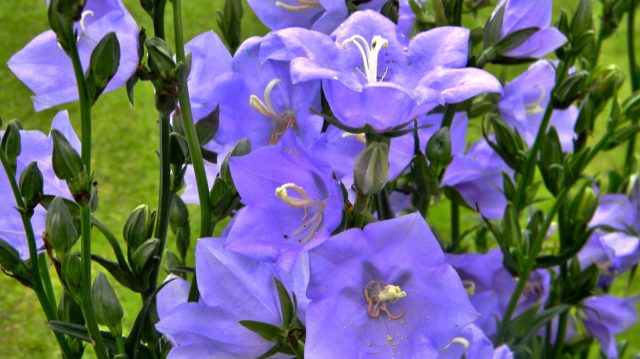
The buds of Takion Blue are directed upwards, and do not droop, as in most varieties
Moerheimii
The Moeirheim bell is considered one of the most beautiful varieties. Semi-double buds reach about 6 cm in diameter, they are white in shade, and pale lilac at the base of the corolla. The plant rises up to 90 cm above the ground.
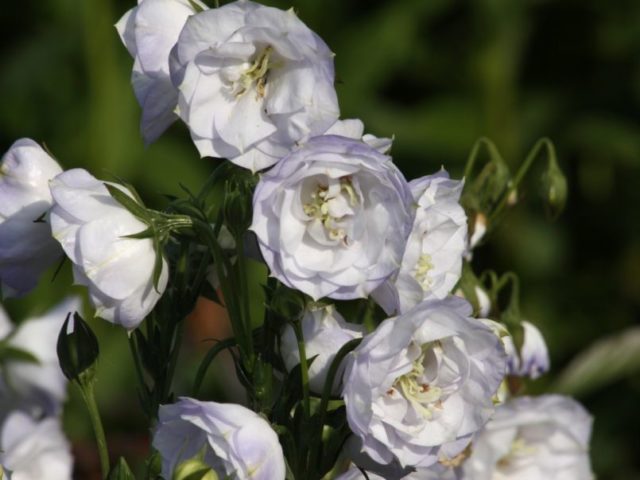
Moerheimii blooms in June and July with beautiful airy buds
Openwork Beauty
The Azure Beauty Blue Peach Bell produces bright double flowers from June to August. In height, the bush rises by an average of 60 cm, has a loose, spreading silhouette up to 50 cm in girth.
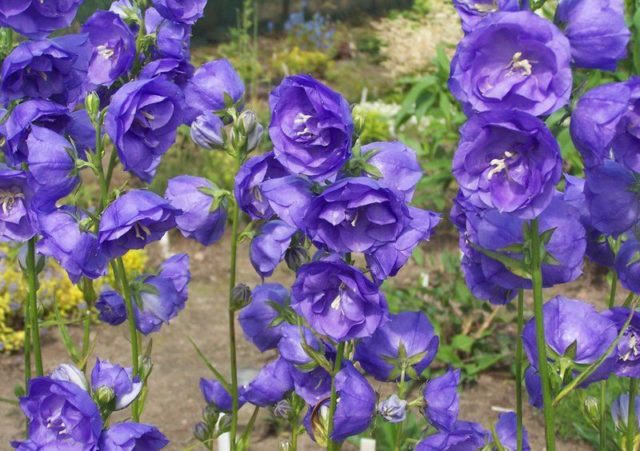
Ajur Beauty variety prefers sunny or semi-shaded areas
Cerulea
The peach-leaved bell of Caerulea rises up to 70 cm above the ground and in June produces delicate flowers of a violet-blue hue.The size of the inflorescences is about 5 cm.
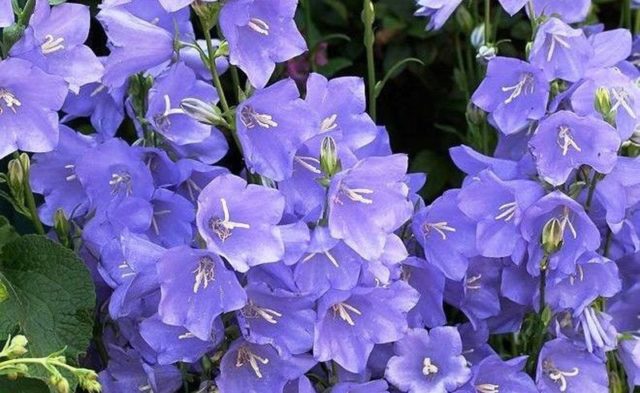
Cerulea loves loose, drained soil and good lighting.
Application in design
In landscape design, low peach-leaved bells are used mainly:
- in rock gardens and rockeries;
Peach-leaved bell withstands rocky soils and enlivens discreet compositions
- in blooming flower beds;
Bellflower gets along well with most perennials
- in the design of garden paths.
Compact low bell bushes highlight the path line
The peach-leaved bell looks good with carnations, foxgloves, delphiniums, lilies, daisy and mallow. It is not recommended to plant it only close to trees and bushes with powerful superficial roots. Tall neighbors will take away nutrients from flowers.
Reproduction methods
There are several methods to increase the population of the peach bell in the country. Namely:
- seeds;
- cuttings;
- dividing the bush.
Most often, flower growers resort to cuttings. The survival rate of the culture is quite high, and the varietal characteristics are preserved in full.
Cuttings
To propagate the perennial peach-leaved bell, in the middle of spring you need to take several shoots about 10 cm long from the middle part of the stem. The leaves on the cuttings are cut in half, and then the shoot is placed directly in moist soil in a permanent place.
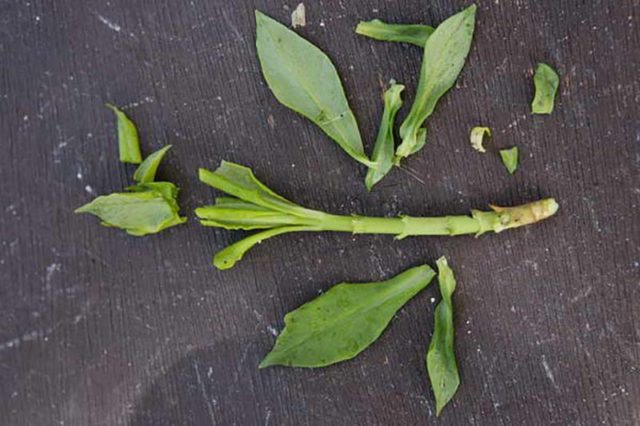
The bell can be propagated by cuttings - they are planted immediately in the ground
To help the plant take root faster, you can cover it with plastic wrap or a cut-off plastic bottle. The culture takes root in an average of 3 weeks.
Dividing the bush
By means of division, adult peach-leaved bells over 3 years old are propagated. The procedure is carried out in May or mid-September, and it looks like this:
- perennials cut off the stems and dig it out of the ground;
- with a sharp knife, divide the rhizome into 2-3 parts with renewal buds;
- the cuts are powdered with wood ash, and then the cuttings are immediately planted in new places.
At the same time, the buds at the base of the rhizome should remain above the ground level.
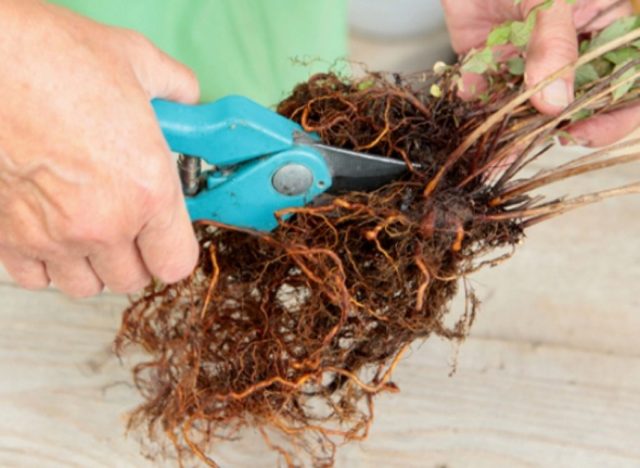
Only adult bells over 3 years old can be propagated by division.
Growing a peach bell from seeds
To propagate the crop, you can use seeds purchased at the store or collected from adult specimens in the garden at the end of summer. If you wish, you can sow the material directly into the ground, do it at the end of May, moisten the site and cover with a film until sprouts appear.
But the seedling method is more popular. It looks like this:
- at the end of April, a mixture of earth, humus and sand is poured into small containers, slightly moistened and seeds are placed shallowly;
- plantings are sprayed from a spray bottle and cover the container with glass or film;
- for 2-3 weeks the box is placed in a room with room temperature, periodically re-moisten the soil and ventilate the seedlings;
- after the appearance of the first shoots, the film is removed.
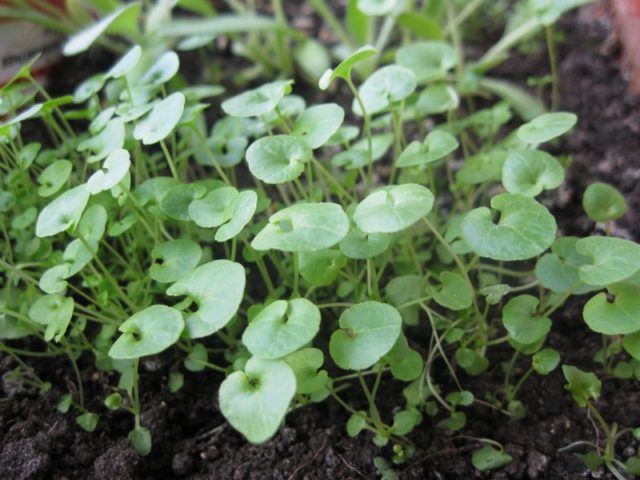
The seed peach bell is grown first at home in a box
When the seedlings produce the first 3 leaves, they will need to be planted in separate containers so that the roots do not have time to intertwine. In mid-June, the seedlings can be transferred to the prepared area in the garden.
Planting and caring for a peach bell
A herbaceous perennial, grown at home or purchased from a store, is not difficult to plant in open ground. The main thing is to choose the right place for the plant.
Recommended timing
The peach-leaved bell is usually transferred to open soil in late May or early June. Return frosts have already passed by this time, so nothing prevents the perennial from quickly taking root.
Site selection and soil preparation
For growing peach bells, choose well-lit areas or light partial shade.The soil should be fertile and loose, with good drainage to prevent moisture accumulation.
In general, the herbaceous perennial is undemanding to the composition of the soil. But a month before planting, it is still recommended to dig up the site and add lime and humus. Mineral fertilizers - potash and phosphorus - are placed directly into the hole.
Landing algorithm
For planting, choose the most developed of the seedlings with long healthy roots and green leaves. A shallow hole is dug, twice the volume of the underground part of the plant.
The hole is half filled with a mixture of sand, humus and turf with the addition of lime, and then the bell is lowered, the roots are straightened and the rest of the soil is poured. After planting, the plant must be watered immediately and, if necessary, additionally tamped wet soil.

The peach bell hole does not have to be deep - only twice the roots
Watering and feeding schedule
Watering peach bells needs moderate watering, it is carried out when the soil dries out. It is important not to overmoisten the plant, otherwise the roots will start to rot.
After reaching 2 years of age, the herbaceous perennial is fertilized twice or three times a season. In early spring, nitrogen fertilizers are applied in combination with ash to gain green mass, during flowering, phosphorus and potassium preparations are added. In September, if necessary, the culture can be fed with potassium again, this will increase the winter hardiness of the plant.
Loosening and weeding
At least once a month and after each watering, the soil at the roots of the bell must be loosened. With poor access to oxygen, the plant develops worse and moreover often suffers from fungi.
Weeds are dangerous for the peach bell. Simultaneously with loosening, they must be weeded out, completely removing them from the ground. Self-sown grasses in the area with perennials take useful substances from the soil and interfere with the healthy development of the culture.
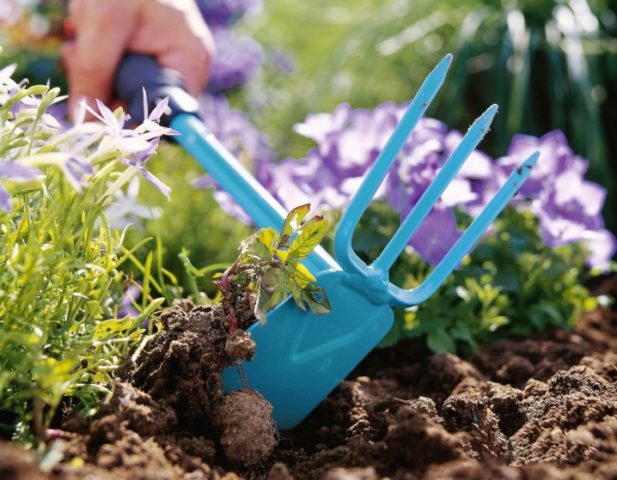
The bell requires the obligatory loosening of the soil from weeds and for the access of oxygen
Garter
The peach-leaved bell is a fairly tall plant with abundant flowering. The stems can bend strongly to the sides under the weight of the buds, which spoils the silhouette of the herbaceous perennial. Upon reaching its maximum growth, it is customary to tie the culture to a support; any beam or stick, a section of a fence or a lattice can become it.
Preparing for winter
At the end of September, the stems of the peach-leaved bell are cut flush with the ground surface. Then the flowerbed is covered with peat or compost with a layer of 10 cm. Organic matter will provide insulation for the winter and, moreover, nourish the roots with useful substances.
Diseases and pests
Bells rarely suffer from ailments and insects. But under unfavorable conditions, they can be struck by:
- rust;
With rust, yellow pads appear on the underside of the leaves
- powdery mildew;
Powdery mildew appears as a whitish bloom on the leaves and leads to wilting
- rot of the root collar.
Root collar rot when neglected leads to the death of the bell
To combat fungi, drugs Fundazol and copper sulfate are used. For the purpose of prevention, it is very important to monitor the moisture content of the soil, diseases develop precisely in swampy soil.
As for pests, the main danger for the bell is:
- slugs;
Slugs eat juicy bell leaves in rainy weather, especially active at night
- aphid;
Aphids stick around the plant in large colonies and can quickly destroy it
- leafhoppers.
Leafhoppers lay eggs on leaves, and larvae feed on bellflower juice
It is customary to use soapy water against pests, as well as garlic water and insecticides, for example, Fitoverm.To prevent the problem, you should regularly loosen the soil where the insects lay their eggs.
Interesting Peach Bell Facts
In culture, the peach bell has been known for over 500 years; it has been grown in simple and refined flower beds in Europe and Eurasia since the Middle Ages.
According to English legends, the plant attracts wealth and prosperity to the house. In the old days, humble wildflowers were often used to decorate dwellings.
The peach bell has many valuable properties. It is able to fight inflammation, accelerate wound healing and improve blood composition. That is why its population is declining so quickly, mass harvesting puts the natural forms of the plant on the brink of extinction.
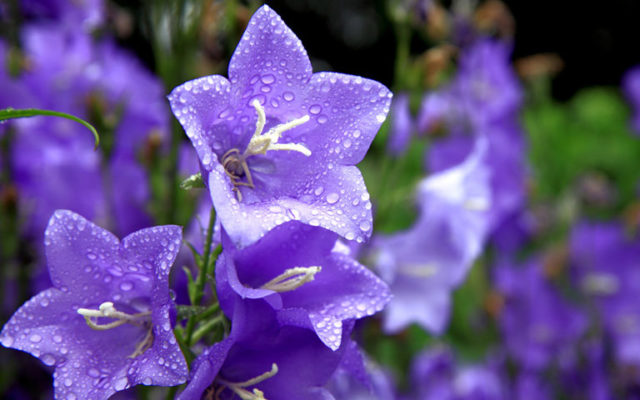
The humble but beautiful peach-leaved bell has been cultivated for 500 years.
Conclusion
Peach bellflower is a simple but very attractive perennial garden plant. White, blue and purple buds can decorate flower beds from the beginning to the end of summer, and it is quite easy to care for the crop.

